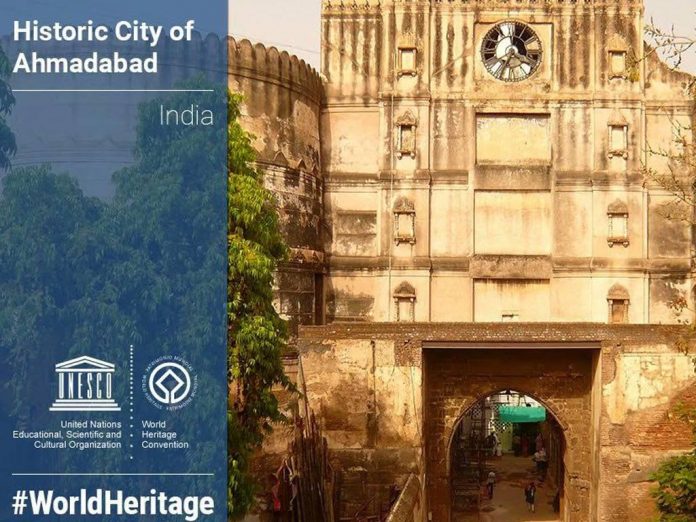United Nations Educational, Scientific and Cultural Organization (UNESCO) World Heritage Committee met for its 41st session in Krakow, Poland, from 2nd to 12th July 2017
- During the session, the World Heritage Committee, chaired by Jacek Purchla, examined the state of conservation of 99 sites already on the World Heritage List and of the 55 sites on the List of World Heritage in Danger.
- The Committee also decided on the inscription on the World Heritage List of 33 nominated sites, which include six natural sites, 26 cultural and one that is proposed both as a natural and cultural site.
- Issues concerning the implementation of the World Heritage Convention were also discussed by the committee.

- During this session 21 new sites have been inscribed to UNESCO’s World Heritage List. Among these were 18 cultural and three natural sites. In addition to the new inscriptions, the Committee also approved five site boundary changes.
- Including the new additions, the total number of sites on the World Heritage List now stands at 1073.
- Angola and Eritrea saw their first sites join the List during the 41st
- The World Heritage Committee consists of representatives from 21 of the States Parties to the Convention Concerning the Protection of the World Cultural and Natural Heritage, elected by the General Assembly of States Parties to the Convention.
UNESCO votes to declare Hebron an endangered site
UNESCO has recognised the old city of Hebron in the West Bank as a Palestinian world heritage site. UNESCO voted 12 to three – with six abstentions – to give heritage status to Hebron in the Israeli-occupied West Bank.
About Hebron:
- Hebron is home to more than 200,000 Palestinians and a few hundred Israeli settlers, who live in a heavily fortified enclave near the site known to Muslims as the Ibrahimi Mosque and to Jews as the Tomb of the Patriarchs.
- Hebron is one of the oldest cities in the world, dating from the Chalcolithic period or more than 3,000 years BC and at various times was conquered by Romans, Jews, Crusaders and Mamluks.
- The ruling also puts Hebron on UNESCO’s ‘in danger’ list, which allows for the allocation of immediate World HeritageFund assistance and alerts the international community to endangered sites.
Vienna historic center put on UNESCO heritage in danger list
Historic Center of Vienna has been put in UNESCO’s list of sites ‘in danger’ due to a high-rise construction project there.
More Details:
- UNESCO World Heritage Committee said the project for the Vienna Ice-Skating Club Intercontinental Hotelis against the body’s earlier decisions that put a limit on the height of new constructions in the oldest part of the Austrian capital.
- It said the project will have a negative effect on the outstanding universal value of the site that dates to Celtic times and is on the UNESCO World Heritage list.
- The list of sites in danger draws the international community’s attention to conditions that threaten value of unique sites.
About Vienna Historic Center:
- The historic centre of Vienna is rich in architectural ensembles, including Baroque castles and gardens, as well as the late-19th-century Ringstrasse lined with grand buildings, monuments and parks.
- It was added to UNESCO’s World Cultural Heritage list in year 2001.
UNESCO omits Great Barrier Reef from ‘List of World Heritage in Danger’
At the 41st annual Conference, UNESCO World Heritage Committee has decided to omit Australia’s Great Barrier Reef in the “List of World Heritage in Danger”.
- This decision comes as an endorsement of Australian Government’s Reef 2050 plan for protecting and managing the Reef until 2050.
- However, in a draft document, the World Heritage Committee noted with “serious concern” coral bleaching along the Great Barrier Reef, and asked for an overall report on the state of conservation by December 2019.
- It is to be noted that as per Australian scientists, continuous bleaching events in 2016 and 2017 have devastated a 1,500 km (900 miles) stretch of Great Barrier Reef.
Coral Bleaching:
- Coral bleaching occurs when coral polyps expel algae that live inside their tissues. Expelling the algae consequentially drains its colour.
- As the algae provide the coral with 90% of its energy, after expelling the algae the coral begins to starve.
- Above-average sea water temperatures caused by global warminghave been identified as a leading cause for coral bleaching worldwide.
About Great Barrier Reef:
- The Great Barrier Reef, off the coast of Queensland in north-eastern Australia, is a 2,300km-long ecosystem comprising thousands of reefs and hundreds of islands made of over 600 types of hard and soft coral.
- It was inscribed as UNESCO World Heritage Site in year 1981.
UNESCO Declares China’s Hoh Xil Nature Reserve a Heritage Site
UNESCO has declared the Hoh Xil nature reserve in China’s Qinghai Province a natural heritage site in a controversial decision challenged by pro-Tibet activists.
About Hoh Xil nature reserve:
- The Hoh Xil nature reserve, located on the Qinghai-Tibet Plateau, is home to over 200 animal species.
- More than 20 of them are state-protected, including the Tibetan antelope.
- It is China’s largest world natural heritage site, covering an area of 45,000 square kilometres.
- China has invested billions of dollars into resettling Tibetan herders out of the reserve, who have for centuries led a nomadic life, moving regularly to seek fresh grazing for their animals.
- Pro-Tibet activists worry about the disappearance of a lifestyle that has endured for hundreds of years, and see the resettlements as part of a broader erosion of Tibetan culture in China.
UNESCO declares Ahmedabad as world heritage city
The 5.5 km walled city area in Ahmedabad, Gujarat with an approximate population of four lakh has been declared India’s first World Heritage City by UNESCO.
- Ahmedabad was in competition with New Delhi and Mumbai for the title.

- A proposal in this regard was sent to the UNESCO in 2010 at the behest of PM Modi, who was then Chief Minister of Gujarat.
- The city had figured in UNESCO’s tentative list in 2011.
- Ahmedabad has now joined the privileged club of heritage cities like Paris, Cairo, Edinburg and two cities in the subcontinent, Bhaktpur in Nepal and Galle in Sri Lanka.
About Walled City of Ahmedabad:
- The walled city of Ahmedabad was founded by Ahmed Shah in 15th
- It has 26 Archaeological Survey of India (ASI)-protected structures and numerous sites associated with Mahatma Gandhi who lived there from 1915 to 1930.
- It is constituted out of residential settlements called ‘Pol’ and has a specific scale of its community-based settlement grouping. Several of such settlements combined together forms a ‘Pur’
- The historic city has several ‘Pur’ neighbourhoods forming the entire fortified historic city.
- These various ‘Pur’ have its own urban structure which is self-sufficient for the communities.
Brazilian Port Where Slaves Arrived Given UNESCO Status
The Valongo wharf in Rio de Janeiro, where slaves from Africa first arrived in Brazil has been added to the list of UNESCO World Heritage sites.
About Valongo:
- World Heritage Committee said Valongo was a reminder of the estimated 900,000 Africans who were brought there by slave traders starting in 1811.
- Valongo is where the slaves, often emaciated and sick after the voyage, were taken to be quarantined, sorted and sold.
- Today the Valongo site is not on the water, but well inland, following expansion of the original city. The remains were only discovered by accident in 2011 during massive works to refurbish the port area for the 2016 Olympics.
- For Valongo, the world heritage honour makes it a twin with Ile de Goree, a small island near Dakar harbour that was chosen in 1978 as the emblem of the departure points for slaves from West Africa on their way to the Americas.
Japan island that bans women is UNESCO Heritage site
Okinoshima, a sacred island in south-west Japan that bans women and where male visitors must strip naked before going ashore has been declared a UNESCO World Heritage Site.
About Okinoshima:
- Okinoshima, located midway between the south-western main island of Kyushu and the Korean peninsula, was once the site of rituals to pray for maritime safety and a centre for relations with China and Korea that stretch back as far as the fourth century.
- The island has a surface area of 240 acres.
- Priests from Munakata Taisha, a group of Shinto shrines, are in principle permitted to travel to worship at the island’s 17th century shrine, Okitsu.
- In addition, up to 200 men are allowed to visit only once a year, on 27 May, to honour sailors who died in a nearby naval battle during the 1904-05 Russo-Japanese war.
- The reason for the ban on women has never been publicly stated.
- Okinoshima is home to a huge collection of artefacts attesting to its importance as an early centre of international exchange.
Cambodian Temple Site Gets UNESCO World Heritage Status
Sambor Prei Kuk, an ancient temple site in Cambodia has been added to the list of UNECO World Heritage Sites.
About Sambor Prei Kuk:
- Sambor Prei Kuk, or “temple in the richness of the forest” in the Khmer language, located 206 km (128 miles) north of the capital Phnom Penh, is home to numerous temples, ten of which are octagonal.
- UNESCO said the area had been identified as Ishanapura, the capital of the ancient Chenla Empire, a Khmer civilization that flourished in the late 6th and 7th centuries and preceded the Khmer Empire.
- Two other sites in Cambodia already have heritage status. Angkor Wat and Preah Vihear, 11th century temples on the border between Thailand and Cambodia, were listed as World Heritage Sites in 2004 and 2008, respectively.
List of 21 new sites that have been inscribed in UNESCO’s World Heritage List during 41st annual UNESCO World Heritage Committee conference
| Site | Type | Country/Countries |
| Aphrodisias, archeological site and marble quarries | Cultural | Turkey |
| Asmara, modernist city of Africa | Cultural | Eritrea |
| Assumption Cathedral and Monastery of Sviyazhsk | Cultural | Russia |
| Caves and ice age art in the Swabian Jura | Cultural | Germany |
| Hebron/Al-Khalil Old Town | Cultural | Palestinian territories |
| Historic city of Yazd | Cultural | Iran |
| Kujataa Greenland, sub-arctic farming landscape | Cultural | Denmark |
| Kulangsu, historic international settlement | Cultural | China |
| Mbanza Kongo, political and spiritual capital of the Kingdom of Kongo | Cultural | Angola |
| Sacred Island of Okinoshima | Cultural | Japan |
| Taputapuātea, center of the “Polynesian Triangle” | Cultural | France |
| Tarnowskie Góry, lead-silver-zinc mine | Cultural | Poland |
| Sambor Prei Kuk temple zone | Cultural | Cambodia |
| English Lake District | Cultural | United Kingdom |
| Valongo Wharf, archeological site | Cultural | Brazil |
| Venetian Works of Defense | Cultural | Croatia, Italy, Montenegro |
| Khomani Cultural Landscape | Cultural | South Africa |
| Historic city of Ahmedabad | Cultural | India |
| Landscapes of Dauria | Natural | Mongolia, Russia |
| Los Alerces National Park | Natural | Argentina |
| Qinghai Hoh Xil, world’s highest and largest plateau | Natural | China |







